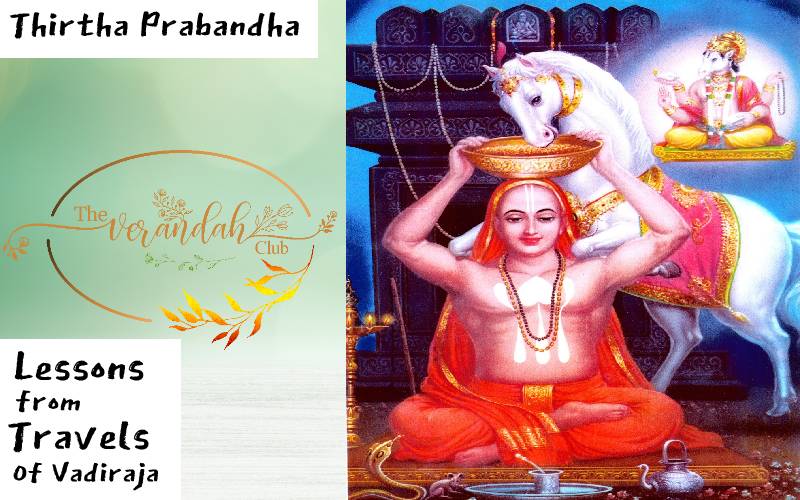
‘Tirtha Prabandha’ was composed by Saint Vadiraja. It consists of 235 stanzas. The dvaita sampradaya enriched our country further. It was propounded by Saint Madvaacharya and later enriched by Jayatirtha, Vyasaraja, Vadiraja, and Raghavendra. Each one of these great souls travelled to different parts of the country in order to offer knowledge, wisdom, and devotion to the people of our ancient land. Saint Vadiraja's, ‘Tirtha Prabandha’ is a seminal work. The travelogue gives us a lot of details connected with the historical and religious importance of each sacred spot which was visited by Vadiraja.
Saint Vadiraja was a sanyasi for 112 years and his composition, ‘Lakshmi Shobane’ unveils it in many verses. The travelogue, ‘Tirtha Prabandha’ is a small text, but has been written in a meaningful manner. It is rendered with care and love. There are not many Sanskrit texts which talk about traveling. Therefore, this text is among the few and rare ones. The works of Kalidasa and Bana do not talk much about the details that are expressed by Vadiraja.
The sins committed in other places would be destroyed through a pilgrimage. However, the sins committed during a pilgrimage will stay for good. Pilgrims undertaking a visit to holy places should first get mentally prepared for the travel. They should first acquire the required knowledge about the temples and centres found in the travel plan. The details will include the importance, historical background, and prayers that should be recited at the time of a holy bath. It will also include the rules and regulations which have to be adhered to. The mind should be prepared first, and the pilgrim should follow his or her regular prayer routine even during the pilgrimage period. Ekadasi vratam, chaturmasyam, trikala sandhya vandhanam should be done during the course of travel.
The land which is fit for ploughing is known as kshetram, similarly the place that can be ploughed with wisdom is known as tirtha kshetram. Kshetram-s are therefore meant for growing grains, similarly tirtha kshetram-s help us cultivate wisdom. Tirtha Yatra (Pilgrimage) is a very important duty in our lives. We should prepare ourselves well before undertaking the travel. While it is good to plan for our food and stay, it is equally important to prepare ourselves mentally before undertaking a pilgrimage.
Travels help us acquire wisdom. We get to meet people belonging to several linguistic and cultural backgrounds. Our body gets better because of the different climatic conditions that are experienced by us. Such travels involve a lot of walking, climbing steps, hills, crossing rivers, and abstinence. This enriches the body and the soul. Diseases of the body and the mind get cured. Walking on the hills is kind of an acupressure treatment and we are sure to reap benefits. Seeing different kinds of icons of deities give us colour therapy. The sacredness of the waters, the vastness of the oceans, the steepness of the mountains, the beauty of the icons gives a lot of joy to the pilgrims. Madhvaacharya is among the most travelled persons in recent times. He had been to numerous sacred places.
Acharya Madhva had travelled from the Himalayas to Sethu twice and had visited ‘Moola Badri.’ Teekaacharya (Jayatirtha), Chandrikacharya (Vyasaraja), Parimalacharya (Raghavendra) are among the other great yatis who had travelled quite a bit. Their travels enriched the society. The Dasas - Purandara Dasa, Vijaya Dasa, Gopala Dasa, and Jagannatha Dasa had also travelled extensively. Purandara Dasa has spoken about his travels in 125,000 of his songs.
Saint Vadiraja has composed 99 verses on the religious centres found in the south, 46 in the north, 43 verses in the east, and 47 in the west. This makes up the total to 235 verses. The Vedavyasa samputa was part of Vadiraja's travel. This samputa could never be opened and this is said to demonstrate the unique qualities of Lord Narayana. There are several other beliefs also. People afflicted with leprosy get cured by following a certain ritual in Subramanya Temple (Karnataka). Kumaradhaara began to flow from the water that was used for bathing Lord Subramanya on being anointed as the Commander-in-Chief of the Devas. These waters are said to be extremely sacred.
Stories of this kind are found in plenty in the ‘Tirtha Prabandha’ of Saint Vadiraja. The purpose of a pilgrimage is to clean up the past. While doing so, one should not add it to the issues. Saints like Vadiraja have helped us to traverse our lives with good merit. Saint Vadiraja had lived during the Vijayanagar Era. A bit of cultural revival had taken place under these rulers who governed from Hampi and later Chandragiri. Several places of worship were restored and newer ones had been constructed too.
Saint Vadiraja used to move along with disciples and halt only in places which would have clean source of water. The retinue would be carrying vessels, manuscripts, and palm leaves which would be used for writing. Disciples and associates would note down points in their mind and recall the same during the discussions. Students would read and write in the nights. The Saint would give dictations to them during the course of travel. The prayer idols, saaligramam-s and vessels would be taken in separate vehicles which would include palanquins.
The Saint would worship the deities in each of the religious centres. Local priests, merchants, administrators, and scholars were ever ready to do their bit. Vadiraja performed each and every religious duty during the course of his travel. Chaturmasyas with the prescribed diet was observed. It would mean a temporary halt to the travel plan. Disciples would follow the prescribed rules during the course of travel. Vadiraja and his entourage met up with a variety of people during their visits. The Saint had entered the Brindavanam in a same manner as Saint Raghavendra. He had done so even earlier. Vadiraja had installed several shivalingamurthies during his course of travel.
Saint Vadiraja gave lectures, prayed in temples, wrote, taught, and meditated during the course of his travels. He helped people to solve their problems. Several issues were sorted out. Besides all this his visits were a rejuvenation for the society of the times. The country had been facing a lot of challenges after the fall of the Vijayanagar Empire. Vadiraja's tirtha yatra-s have enriched our country.
Aspirants who are keen to take a spiritual journey through a pilgrimage can pick up a lot by learning about the travels of Saints like Vadiraja. Pilgrimages will help us to lead a satvik life and we will become free from hatred, jealousy, and anger. The removal of base thoughts will make us better people. The best takeaway from any pilgrimage will have to be spiritual progress and concern for fellow humans. Understanding the real purpose of a pilgrimage by following the footsteps of Saint Vadiraja will do us a lot of good.
 Mr. Rajesh Govindarajulu is one of the founding members of the Verandah Club Pvt. Ltd. He is a leading columnist, historian, jeweler, entrepreneur, and a heritage enthusiast who is earnestly working to revive the past in the light of the present. Experiential learning about the history of Coimbatore is his main course of interest and he is also a panel member of many colleges in the city.
Mr. Rajesh Govindarajulu is one of the founding members of the Verandah Club Pvt. Ltd. He is a leading columnist, historian, jeweler, entrepreneur, and a heritage enthusiast who is earnestly working to revive the past in the light of the present. Experiential learning about the history of Coimbatore is his main course of interest and he is also a panel member of many colleges in the city.
NEXT ARTICLE

At the southernmost tip of this mesmerising ensemble lies the majestic Great Nicobar Island, boasting an impressive landmass of about 910 square kilom...

Bharath has always been a land traversed by spiritual masters/ Guru since time immemorial. These spiritual masters have always upheld the core princip...

South India contains its fair share of unique pilgrimage centres. These divine places of worship have a prominent Sthala Purana, devoted followers, di...